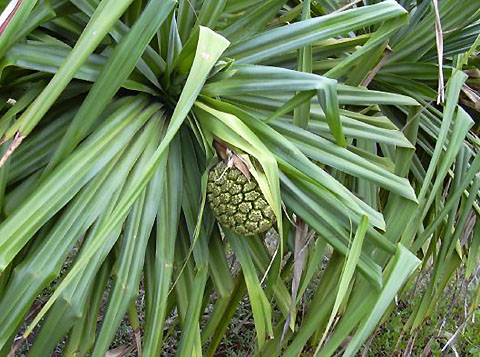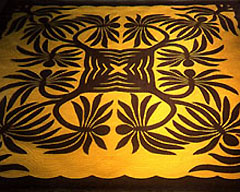Birds
and Plants of Kauai:
Hala
by Linda
Pascatore on 5 March 2006
The
Hala, also called the Screw-Pine or Pandanus tectorius, is a palm-like
tree which can grow to 20 feet. The trunk is light colored with
markings where the leaves have fallen. Leaves are long, slender
and saw-toothed with sharp spines on the edges. The leaves are bent
and arranged in a spiral pattern, as the common name screw-pine
suggests.
Proproots or aerial roots grow around the trunk, giving the hau
the nickname “walking tree”. When it is said that a
mother’s children “are like the many-rooted hala of
the mountain side”, it means that she is like the trunk of
the tree, surrounded by many loving children like the roots of the
hala.
The male tree has white flowers, called hanano, but no fruit. The
hanano flowers attract insects and bees which then carry the pollen
to the female tree. The fruit of the hala looks a little like a
small pineapple, and is about 8 inches in diameter.

Fruit of the Hala (Screw-Pine) on female tree
The fruit is
red or yellow when ripe, and broken into keys or sections. The inner
part of the keys is edible and sweet, but very stringy. The keys
float, and can float for long periods in seawater, and still seed
a new tree. The Hala may be indigenous to Hawaii, but also could
have been brought here by the Polynesians.
Hawaiians used hala leaves for weaving lauhala mats (lau means leaf),
and hats, fans, baskets, canoe sails, and bags. Leaves were also
used for thatching roofs. Hawaiians traditionally used hala leaves
to cover dead bodies. The pollen of the male flower was considered
a love potion, and was also used to preserve feathers and leis.
The young root tips were medicinal. The wood of the tree has been
used to make posts and calabashes. The keys were dried and used
as paint brushes for decorating tapa cloth.
Hala is found on all Hawaiian islands, and also throughout Polynesia,
and as far as Australia. In Hawaii, it can be found along the shore,
on steep cliffs, and in lowland forests. The Hala was originally
the dominant tree in the lowland wet forests of the Hawaiian Islands.
According to legend, when Pele first landed in Hawaii, her canoe
was caught and tangled in the roots and leaves of the hala. In anger,
Pele ripped up the tree and threw it across the island. The resilent
hala rooted and sprouted wherever it landed, and became one of the
most abundant trees.

Hawaiian quilt with Hala tree pattern
|




